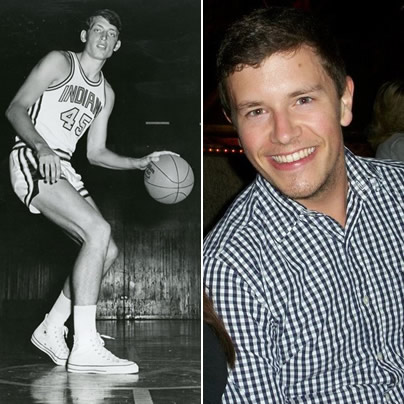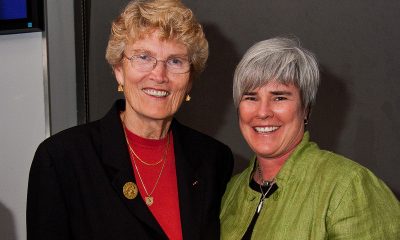Living
Back to School: How it got better at William & Mary
Trammell on the importance of mentoring new generation


The future rector, Jeff Trammell (class of 1973), was captain of the basketball team. (Photo courtesy of Trammell)
Editor’s note: This is the second installment in the “Back To School” series assessing the LGBT climate on university campuses as told by alumni we’re pairing with current students to tell their stories. This week: Jeff Trammell and William & Mary. Next in the series: Lesbian author Fay Jacobs returns to American University.
Speaking of her beloved college, the acclaimed actress Glenn Close once said, “I have an indestructible, visceral connection to this place — a connection which is vital and real and which has sustained me through good times and bad.”
This loving endorsement of William & Mary by Close threads the needle for this series. As we explore the experiences and struggles of gay alumni, the actress known for her roles in “Dangerous Liaisons” and “Fatal Attraction” serves apt imagery.
For Jeff Trammell, in the early 1970s, any same-sex liaisons would have been dangerous — and any attraction could be fatal to his reputation, or worse.
So, while heterosexual classmates were sewing their wild oats, Trammell buried himself in books, basketball and life in the Lambda Chi fraternity. One can picture him with 20 pounds of history books in his backpack, waiting in line to use a public pay phone to call his “date” — a coed with whom only polite conversation would take place. No liaisons, no attractions. The oats he sewed were mild. He only risked coming out once, quietly, to his straight little brother in the fraternity. Much later in life, Trammell would come to lead the Lambda Alliance for LGBTQ’s, but, typical of Trammell, he didn’t drop his ties to Lambda Chi. To this day he is thankful to — and a dear friend of —his little brother and sole confidant, Dave Blount.
Trammell took one shot at wild oats back then. It was a secret mission into D.C. to check out the legendary gay bar, Lost and Found. He arrived at 7 p.m. and entered solo. The bartender just laughed and said, “Come back at 11.” The star senior hoopster was a rookie in gay life so he anxiously sat out in the parking lot. Once inside at the stroke of 11, he saw men dancing with men. As he puts it, “Breathtaking.” But, across the crowded dance floor he spotted the captain of the tennis team, and frightened, he slunk into the shadows, “which is not easy at 6’7″.”
Like many southern boys, Trammell relies on those immortal words from “Steel Magnolias”: “That which doesn’t kill us makes us stronger.” And strong is an understatement. Settled down with Stuart Serkin, his husband with whom he has danced for 36 years, they laugh at having met taking the Florida Bar exam — and Serkin had to coax out of Trammell that his great uncle was indeed “that” former Gov. Trammell of Florida. Their first date was to see “Who’s Afraid of Virginia Woolf” and here they are 36 years later watching the potential reality horror show “Who’s Afraid of Virginia Under Ken Cuccinelli?” But, ever present in their politics, both are at the barricades working for Democratic gubernatorial candidate Terry McAuliffe.
Trammell has worked for Democrats on Capitol Hill for decades, run LGBT outreach for both the Al Gore and John Kerry campaigns and gone toe-to-toe on gay issues with the likes of Sean Hannity and Bill O’Reilly on Fox News. Throughout his life, he has always stayed involved in William & Mary alumni affairs. Last year, he agreed once again to mentor an undergrad — this time Davey McKissick, a senior whose experiences are quite different.
First off, McKissick’s books and phone are both on his iPad, and literally balanced in the palm of his hand. In his other hand? His boyfriend’s. No pay phones, no book bags, no coed “beards.” And if McKissick were single and ran into a gay tennis player, he wouldn’t feel the need to run away. He leads an authentic life. He has learned his gay history through documentaries, lectures at W&M and through Trammell. His ambition was to intern in D.C. and among the 15,000 alumni in the D.C. area, he’s sitting at Trammell and Company with Jeff — the first openly gay board chair (rector) of a major university.
William & Mary elected the first openly gay board chair of a major university in the United States. It didn’t happen in Cambridge, Berkley or Madison. It happened in Williamsburg, Va. “I owe it all to the GALA students and faculty at the university,” Trammell said. “They created the climate for this to happen.” There are many reasons to look up to this former basketball star, and his height isn’t even at the top of the list. Start with McKissick’s gay hero, Barney Frank. It so happens that Trammell co-founded Stonewall Democrats with Frank, so the next thing you know, bang, McKissick is shaking hands with his hero. McKissick is interested in LGBT outreach at the DNC, and poof, he’s sitting in the director, Jeff Marootian’s office, working the Obama-Biden campaign.
When not mentoring students, Trammell can be found funding LGBT lectures at W&M with Chris Bram, fellow alum and the author of “Gods and Monsters,” or helping to fund the Boswell Project, named for John Boswell, class of 1969 — the historian of same-sex relationships in the middle ages. Ironically, Boswell was lost in the AIDS plague. Or you can find Trammell working with David Mixner on the gay issues documented in the U.S. Holocaust Museum. He’s been appointed to the board of the Association of Governing Boards of Universities and Colleges, which represents 38,000+ trustees across the U.S. He’s answering his Blade interview questions at 1 a.m. and then at press time, he’s on the front page of the Washington Post dealing with the new tuition structure. Throughout, his trips to Williamsburg and Richmond are frequent.

Davey McKissick (class of 2014) has led a very different life on campus than his mentor, Jeff Trammell (’73), at William & Mary. (Photo courtesy of McKissick)
Back in Williamsburg, McKissick has already navigated the same gauntlet of traditions Trammell did — swimming the Crim Dell pond, jumping the wall of the Governor’s Mansion, and running the Sunken Gardens. But today, gay campus life is lived in Technicolor with Pride festivals, movie nights and the occasional drag show. There are “safe zones” throughout campus, letting LGBT students know they are welcome.
Reflecting on all this change, Trammell recalls his mother’s reaction late in life to his coming out post-college.
“Well, she was very WASPy and southern and that adds up to being polite,” Trammell said. “She said ‘Oh, honey, I’ve known that for a long time. Now, we don’t need to talk about it’.”
He got unconditional love, but conditional parameters for discussing it. McKissick’s answer to the question about his straight heroes is heart-warming. He answers: “Betty and Ron.” That would be his parents, the McKissicks.
“I could not ask for more supportive influences in my life,” he said. “They motivate me to set high goals for myself and to be relentless in achieving them.” Betty and Ron have no problem talking with — or about — their son.
“It’s remarkable to see Davey is fully out and authentic, things not possible for me back then,” Trammell said. “I think no matter what the size of your alma mater, gay alums should get back involved and support their students.”
As rector, he will officiate commencement at William & Mary Hall this summer, on the same floor he played his first basketball game.
The college marks 1918 as admitting the first woman student and 1951 the first African American. Gays have been there since 1693, but the price to pay for being admitted was no admission of who you were. Those days are steadily fading behind us. Because of its history, W&M has been called “the alma mater of a nation:”
Hark the students voices swelling
Strong and true and clear
Alma Mater’s love their telling
Ringing far and near
Today, each student’s voice is strong and clear. Liaisons aren’t dangerous and attractions aren’t fatal to your reputation. LGBT alumni proudly join Glenn Close in a visceral connection that has sustained them all through the years.
And so, even from a famed Sunken Garden, when he’s standing on Trammell’s shoulders, McKissick can see nothing but rainbows in a clear blue sky ahead of him.
Read the previous installment of this series at washingtonblade.com. If you have alumni stories to share, reach Brent Mundt at [email protected].

Electric-vehicle tax credits may have faded earlier this year, but EVs themselves are far from losing their spark. There are more charging stations than ever, battery ranges are longer and more realistic, and automakers have finally figured out that EVs don’t all need to look like geeky science projects or feel like failed beta tests.
Just look at these two compact electrics, which are futuristic, fun and flexible enough for work or play.
HYUNDAI IONIQ 5
$37,000 to $48,000
Range: 245 to 318 miles
0 to 60 mph: 4.5 to 7.4 seconds
Cargo space: 26.3 cu. ft.
PROS: Fast charging. Roomy cabin. Silky-smooth suspension.
CONS: Wide turning radius. Rear wiper not on all trims. Price creep.
After being introduced three years ago, what’s new for the latest Hyundai Ioniq 5? Mostly refinement. Charging is quicker, software is smarter and Hyundai continues to quietly listen to feedback, tweaking ride comfort and usability. Think of it as switching from messy eyeliner to a perfectly sharp wing.
Exterior styling remains one of this EV’s biggest conversation starters. Those pixel-inspired lights, crisp lines and slick hatchback-meets-crossover proportions exude refreshing confidence. There’s no trying to blend in, and that’s the point. Park this Hyundai anywhere and heads will turn.
On the road, the Ioniq 5 prioritizes calm over chaos. Steering is light, the suspension smooths out rough pavement and acceleration feels brisk without being aggressive. Safety tech is plentiful and well-calibrated—adaptive cruise control, lane-centering, blind-spot monitoring—all working together without seeming like a nervous backseat driver. IOW, this ride is supportive, not clingy.
Inside, the user-friendly cabin shines. The flat floor and long wheelbase create a lounge-like atmosphere, with excellent legroom and airy visibility. Seats are well-bolstered and available with eco-friendly materials, and the sliding center console adds flexibility. Cargo space is generous, and the wide windshield makes city driving stress-free. Alas, the rear wiper is only available on select models. Overall, though, I appreciated how everything looks modern without feeling cold.
What makes this Hyundai special is its vibe. An EV that embraces individuality without shouting about it.
Fun fact: The Ioniq’s ultra-fast charging can add hundreds of miles in under 20 minutes—perfect for those who hate waiting almost as much as they hate small talk on awkward first dates.
VOLKSWAGEN ID.4
$46,000 to $59,130
Range: 206 to 291 miles
0 to 60 mph: 4.4 to 7.7 seconds
Cargo space: 30.3 cu. ft.
PROS: Sure handling. Decent range. Good storage.
CONS: Body roll in curves. Fussy infotainment. No frunk.
The latest VW ID.4 focuses on polish. Software updates have fixed earlier frustrations, and overall drivability feels more cohesive. Less “learning curve” and more “hop in and go,” like a dependable bestie who doesn’t overthink things.
Styling-wise, this EV is intentionally inoffensive. Soft curves, friendly lighting and a familiar crossover shape make it approachable. While the ID.4 won’t turn heads like the Ioniq 5, that’s OK. It’s more akin to a classic outfit that always works—timeless, not trendy.
Driving the ID.4 is relaxed and predictable. This SUV prioritizes comfort over thrills, with a suspension tuned for daily commuting and long highway drives. Safety features are comprehensive and reassuring, including excellent lane assistance and collision-prevention systems. It’s the kind of car that quietly has your back, no drama required.
Inside, the ID.4 offers a calm, uncluttered cabin with good space for passengers and cargo alike. Rear-seat legroom is especially strong, making it a solid road-trip companion. The seats are plush, visibility is good and while the infotainment system isn’t the most intuitive, it’s improved enough to be more than tolerable.
The ID.4’s special sauce is balance. It doesn’t try to reinvent the wheel—it just electrifies it.
Fun fact: This is one of the most globally popular EVs, proving that sometimes being universally liked is a strength, not a personality flaw. Think, gold star gay who still surprises you.

Real Estate
Child- and pet-proofing your home for the holidays
It isn’t about being perfect but about being prepared

The holidays are meant to be joyful, cozy, and full of laughter — but if you have young children or pets, they can also feel a little chaotic. Twinkling lights, shiny decorations, guests coming and going, and tables full of tempting food can turn your home into a wonderland of curiosity and mischief. The good news? With a little thoughtful planning, you can keep the holiday magic alive while making your home safer for everyone who lives there.
There’s something oddly comforting about movies where animals go to war with holiday decorations, turning carefully strung lights and perfectly placed ornaments into chaos. Whether it’s a mischievous dog tangled in tinsel or a curious cat launching a full-scale assault on a Christmas tree, these scenes tap into a universal experience for pet owners.
The humor comes from the contrast: the human characters are trying to create warmth, tradition, and picture-perfect cheer, while the animals see the decorations as toys, obstacles, or personal enemies. The resulting destruction — trees tipping over, ornaments shattering, lights blinking out—feels exaggerated but relatable, especially during the already hectic holiday season.
Let’s start with decorations because they tend to be the biggest attraction. Ornaments sparkle, garlands dangle, and everything seems designed to be touched, pulled, or tasted. If you have little ones or pets, consider placing your most fragile ornaments higher on the tree and using shatterproof options on the lower branches. Tinsel and ribbon may look festive, but they can be dangerous if swallowed, so skipping them or keeping them well out of reach is a simple way to reduce risk without sacrificing style.
Holiday lights are another favorite fascination. Before hanging them, take a few minutes to inspect each strand for frayed wires or broken bulbs. Secure cords along walls or behind furniture so they’re harder to grab or chew and unplug them when you leave the house or head to bed. Not only does this help prevent accidents, but it also gives you one less thing to worry about during a busy season.
The Christmas tree itself can become a focal point for exploration. Make sure it’s sturdy and well-anchored so it doesn’t tip if a toddler tugs on a branch or a pet decides to investigate. If you use a real tree, cover the water base since tree water can contain additives that aren’t safe if consumed. For artificial trees, keep an eye out for loose pieces or needles that could become choking hazards.
Food is a big part of holiday celebrations, and it’s also one of the most common sources of trouble. Many traditional treats—like chocolate, grapes, raisins, alcohol, and foods containing xylitol—are dangerous for pets. Keep plates and serving dishes up high, secure the trash can, and gently remind guests not to slip pets or kids “just a little bite” without checking first. For children, be mindful of hard candies, nuts, and small treats that could pose choking risks.
Candles and fireplaces add warmth and charm, but they deserve extra caution. Flameless candles are a wonderful alternative if you want ambiance without worry. If you do use real candles, place them well out of reach and never leave them unattended. Fireplaces should always have a sturdy screen or gate, especially with crawling babies or curious pets nearby.
Holiday gatherings bring wonderful energy into your home, but they can also create new challenges. Doors opening frequently make it easier for pets to slip outside, so consider setting up a quiet, comfortable space where they can relax during busy get-togethers. This can help reduce stress for them and give you peace of mind. For children, stair gates, locked cabinets, and clear boundaries can help prevent accidents when there’s extra excitement in the air.
New toys and gifts are another thing to watch closely. Packaging, twist ties, plastic wrap, and especially button batteries should be cleaned up promptly. These items are easy to overlook in the excitement of gift-opening but can be dangerous if swallowed. Taking a few minutes to tidy up as you go can make a big difference.
Lastly, try to keep routines as steady as possible. The holidays naturally disrupt schedules, but familiar mealtimes, naps, walks, and bedtime rituals help children and pets feel secure. A calmer household often means fewer accidents and a happier experience for everyone.
At the end of the day, child- and pet-proofing your home for the holidays isn’t about being perfect but about being prepared. A few small adjustments can help you relax, enjoy your guests, and focus on what truly matters: creating warm, happy memories with the ones you love. When your home feels safe, the holidays feel even sweeter.
Valerie M. Blake is a licensed Associate Broker in D.C., Maryland, and Virginia with RLAH @properties. Call or text her at 202-246-8602, email her at [email protected] or follow her on Facebook at TheRealst8ofAffairs.
Real Estate
In real estate, trust the process
With rates coming down, we could see spring surge in buyers

The average 30-year mortgage rate is falling, little by slowly. With predictions that the rate will continue to adjust downward in the next year or two, there may be a busier spring market than we have seen in the last few year, especially for the DMV market, which has been reeling from thousands of layoffs this past year. The frenzied activity resulting from interest rates close to 3% for some borrowers will probably not occur; however, this spring could add up to be a few notches busier than the last.
What does this mean for buyers and sellers? Lender Tina Del Casale with Waterstone Mortgage says she has seen “low to mid 6’s as the average for conventional loans.” If rates continue downward into the 5% range, there may be more activity than we saw in the last year or two. This could release a little bit of pent up demand.
Many buyers will have found that for whatever reason, their current home is not meeting their needs. Sellers may want to finally take the plunge and put a for sale sign in the yard and online, now that they might find a more reasonable rate on their next home. This winter can be an opportunity to assess financial situations, home conditions, and optimize one’s chances to have a sale with more agreeable terms, or put one’s best foot forward in an offer. In addition to checking with a lender or favorite handy person, let’s review what sellers and buyers typically spend their energy negotiating while enjoying the lovely process called “going under contract”:
- Timelines – Sellers might want to have their house solidly under contract (papers signed, thumbs up from the lenders, all inspection items decided upon and settled) so that they can put an offer down on a new home, and then negotiate that timeline with the other sellers. Remember, making a move is not only about the buyer taking possession of a new home, but also about the sellers figuring out their situation as well.
- Sale Price – unfortunately for buyers, in the eyes of most sellers, “money talks.” So, in a non-competitive situation, a seller might be happy to just get one offer at a price that was within the desired range. As soon as another interested buyer enters the equation, it can become a little bit like RuPaul’s Drag Race, and one will have to lip sync for one’s life, honey! And only one buyer will get to hear the words, “condragulations!”
- Tone/Vibes/Energy in the Room – Remember: Human beings are emotional creatures. All of us have feelings. And all of us want to put energy into situations where we feel appreciated, where a level of self-awareness exists, and a sense that each side is trying one’s hardest to act in good faith. The best transactions I saw were where a little grace was the “grease on the wheels” of the transaction. Occasionally, a buyer had cold feet and wanted to see the unit a few more times before the settlement date, or a seller forgot to scrub the bathroom with a little extra elbow grease before the settlement date. Life happens; misunderstandings can occur. A wise therapist once said: “You don’t have to like it, but can you allow it?” The tone of one or both parties in the transaction can be what seals the deal, or results in one party exiting the contract. (In the case of the dirty bathroom, the seller left a check with the title company for the buyer to pay a housekeeper to come clean what they couldn’t.)
Joseph Hudson is a referral agent with Metro Referrals. He can be reached at 703-587-0597 or [email protected].


















